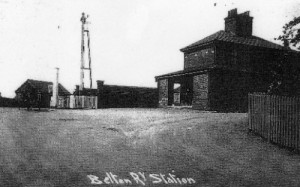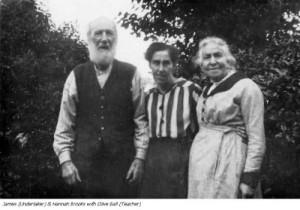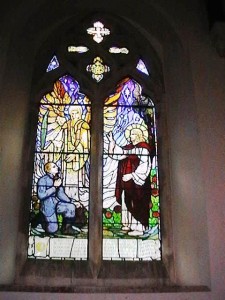
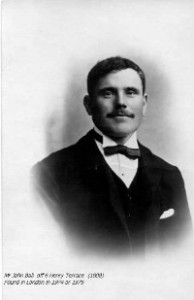


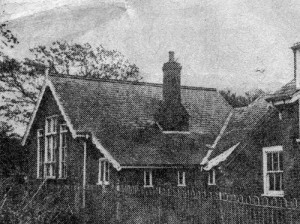



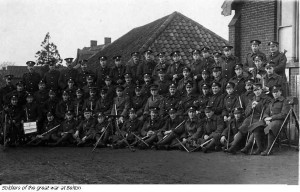

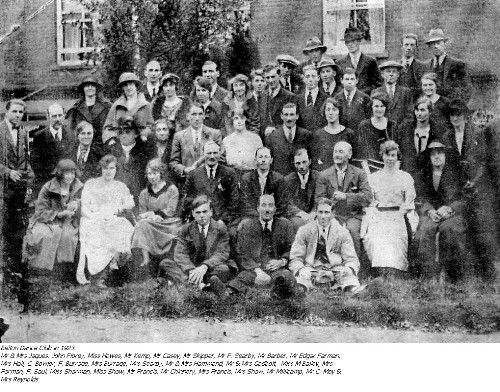


Memories of a Bygone age by Daisy Newham
Scroll to the bottom of the article for more photographs
Daisy was born in Belton and has lived in Bradwell since 1919.
Belton in the years 1800’s – 1900’s was a very small village. Only a few people lived there and everybody knew and cared for each other.
Not many women went out to work as they had large families. They acted as midwives and were always ready to help in bringing up the children. They made most of the children’s clothes and always knitted socks, gloves and scarves. The boys wore short trousers and jerseys lace up boots and a cap. The girls wore jumper’s skirts button up boots, bloomers with a pocket in them for their handkerchiefs and a pinafore. As the children grew out of them they were passed down to the younger children. There was no money for luxuries. Oh how I remember in the 1930’s wearing thick woollen stockings, wide black garters to keep them up and button up boots; we had to use a button hook to do them up.
Most of the men went fishing or worked on the land. There were many small farms. As you walk from Belton Cross Roads, a small lane on the left, I think is called “Back Lane” where there were allotments in the early 1900’s. The first farm was Shacky Bond’s, this was Hall Farm. They had four daughter and a son called Sonny. We used to love watching the animals grazing in their meadows when we visited grandmother and granddad Brooks who lived on the opposite side of the road.
James Brooks and son Tom were well known as they made coffins in a large shed in their garden, which opened onto the road. People used stop and watch them at work. The last coffin Tom made was for Mr Searby who had requested him to make it. I was working at the Searby’s at the time and saw him in his coffin, very peaceful. I was only 15 at the time. This was about 1933.
Holly surrounded the gates of granddad’s cottage. It was called “The Holly’s”. The row of cottages was kept warm by huge black stoves with ovens at the side, and a rack over the top where cloths were aired. These were coal fires, as there was no electric or gas in those days.
I remember a huge apple tree they grew from seed outside the back door. A pump to get the water and a water butt to catch the rain water for washing. We had huge coppers in the kitchen with a fire underneath to make it boil. The other end of the row of house, Jimmy Brooks had his workshop, he was the blacksmith, he did all the iron work as well as shoeing the horses, also his brother Walter who died very young. Walter and his wife Lily had a daughter Nora and twin sons Jacob and Francis. Francis was brought up by granddad and grandmother. He was a well known Marsh man. He married Edie and lived with granddad till he died. They had four children Doreen, Edna, Ernest and Allen. They moved to Burgh Castle. Jimmy married Hetty Rogers and had five children Reggie, Percy, Stanley, Hetty and Ethel, who all went to Belton School. He later married Lou and had Victor and Jimmy and moved to Browston.
Olive Brooks was a teacher at Belton School when Sir John Mills’ father Lewis Mills was Headmaster in the early 1900’s, some of the children she taught were Emily Henry, Margret Botwright Stanley Alden, Bernard Kemp, Edith Thacker, Wilfred Smith, Alice Smith, Hubert Sharman, Florence Beare and Jacob Smith. These are the names in my Mothers Teachers book from the early 1900’s.
These lovely poems were written by soldiers in the First World War, thanking the ladies of Belton for their kindness. Olive was married and lived at 6 Henry Terrace. Her married name was Ball and soldiers were billeted with them.
- At Mrs Balls of Belton,
- Six soldiers once did stay
- And all the six regretted it
- When they had to move away
- The Billet it was comfy.
- The landlady sublime
- Our food was always ready
- Served nice and always up to time
- So when we all get back again.
- And peace is here once more
- We’ll try to visit Belton
- The village by the shore
- To Mrs Ball our thanks are due
- For calling us each day
- And saving us from all C, B,
- Or stoppages in our pay
Second Poem
- If you want to be comfy
- When you sit down to tea
- Just pop down to Belton
- Quite close to the sea
- In the morning quite early
- You are sure of a call
- By the husband who wife’s name
- Is Mrs O. Ball
- I’ve stayed there myself
- So I think I can say
- That Mrs Balls’ of Belton
- Is the best place to stay
Signed
- Curtis.
15th Essex Regiment.
Olive was born in Belton in 1887 and Christened at Belton Church by Rev. F. E. Deck on March 6th 1887. She was confirmed in Belton Church by the Bishop of Thetford.
REV George Venables was rector at Belton Church in 1899 and Rev Leeper in 1901. He gave mum a book of ballads at Sunday school and Rev C. M. Walker preached there. Also Rev Jones was rector in 1927. In May 1900, a church army van visited Belton a photograph of the event was given to Olive signed by the Rev Cautly. He also christened my dad the day he married my mum Olive. Dad had to get permission from the Bishop of Norwich to marry as he was a foundling and brought up in homes in London.
At the age of two he was admitted to Hanwell workhouse schools where he remained until he was fourteen. He was sent to live at Mr Fagan’s home, a small institution in Southwark Bridge Road, but he only stayed a few days, he didn’t like the other boys who stayed there. He was described as having weak eyes and no home, but the workhouse. He was admitted to Dr. Banardos with the intention of placing him in the Union Jack Shoeblack Brigade which provided work for destitute boys. He left Banardos after just Nine days, but they took a photograph of him when he left.
He came to Great Yarmouth and found work as a fisherman on the boat Y H 681 No 28 fishing boat in 1905. He lodged with someone in Englands Lane Gorleston. I have a hymn book that is over one hundred years old with his name and Englands Lane in 1894, so perhaps he lodged with fishermen who lived there. When the First World War broke out he had to leave his boat as they didn’t know his nationality and they put guns on the fishing boat. He was evacuated to Belton and lived with Granddad and Grandmother. He married my Mother and they lived at No. 6 Henry Terrace Belton next to Mr Squires who was the coalman in the early 1900’s, and Yvonne Guyton’s family.
Dad was always called sunlight. Uncle Charlie Reynolds said it was because he was found in a sunlight soap box, but we liked to think that it was because he was always smiling and happy, probably because he had found a loving home at last. Dr. Deane told me in 1940 never to forget your dad because he was born a gentleman. Dr. Deane always remembered him although he died in 1927 and I was only Nine years old when he died. He left mum with me and four brothers, I wrote to Dr. Banardos in 1998, asking for any information but they wrote back saying sorry but they could not help as they had so many telephone calls after their story was on the television, but they would keep me in mind. The next week I had a telephone call from them saying that they had photograph of him at Thirteen years. He was only with them for about two weeks, but they take a photograph of every orphan boy they have. So I was over the moon as my brother Frank was the image of him when he was young. The photograph was taken about 1888 and they kept it over One Hundred years. It’s a beautiful photograph; I was very pleased as it made me feel I knew a little bit more about my dad
When he moved to Belton Dad got a job with Suffolk County Council and worked on the roads with Mr Cutty Newark of Belton. He was a lovely man. I remember he had a white beard. They would meet with their wheelbarrows and brooms. They didn’t have electric road sweepers and grass cutters like they have today. It was very hard work out in all weathers. Dad got pneumonia and died in 1927. We were living in Bradwell then. His job was given to my elder brother Christopher as he was just leaving school.
Mr & Mrs Botwright had a market garden in Belton and they used to deliver our milk.
I’m not sure if it Roger or Harry at my door when someone shot a bird and it dropped at my feet, he said that will make you a nice meal, I said no it won’t, please take it away. This was in the 1950’s.
There were four cottages on Belton Green. Mrs Rumsby lived in the first one, Mrs Reynolds, and then Mrs Cooper and I think Mrs Wright lived in No: 4. Tommy Squires lodged with one of the people before he was tragically killed on the Railway lines. He was a very nice man. Mrs Reynolds had two daughters and a son, Molly, Adeline and Alex. Adeline worked for Mr & Mrs Lark of Hobland Hall during the Second World War. They had lived there since 1891. Mrs Lark was one of the founders of the Bradwell Women’s Institute. She was the first president and very interested in music and in 1927 formed a choral society. Mr Simpson was the organist and a music master from Belton was the conductor. Mr & Mrs Lark approached Mr & Mrs Bussey who lived at Star Farm lodge for a piece of land to build the first village hall in Bradwell in 1928. Their daughter, Mrs Burrell also owned a piece of Gypsy Green. Miss Dorothy Smith of Belton did all their Secretarial work. Mrs Lark died. Dorothy Smith who wrote the Belton book was a direct descendent of the Farman family who lived in Belton for five generations.
My Grandmother’s name was Hannah Farman, she was born in 1851 in Belton, she married James Brooks the undertaker of Belton in the early 1900’s there were brakes and waggonettes on their way to the Kings Head and Belton Gardens. They were pulled by four horses; the wagons were covered with canvas. The people used to throw us pennies as we played with our spinning tops by the side of the road. We cheered them on their way a Mr Alden had a shop at Stepshort for mending boots and shoes. Later this was taken over by Mr. A Kemp, who had the first shop selling newspapers in Belton in the early 1890’s. Teddy Kemp took on the job after Alfie’s retirement in the 1930’s. His patch was Belton, Bradwell and through to St. Olaves. Teddy used to fetch the papers from Middleton’s the newsagents and deliver them around the villages. He always had a cheery smile and a kind word for everyone. Teddy died in 2002.
Mrs Kemp of Blands building was always cheerful. I remember her by her bright red smiling face when you met her on the bus. She received a personal message from Queen Elizabeth the Queen Mother for opening her doors to strangers in need of shelter and sharing her home with them in the Second World War. She also worked on the first tram which ran from Great Yarmouth to Caister – on – Sea. She was a tram conductress in 1905. Her daughter Mrs Vera Howlet told me that the late Lord Somerleyton once gave them a surprise visit one Christmas with a huge Turkey, they had to chop it up to get it into the oven to cook it. It was the best Christmas dinner they ever had. Everybody was so friendly and helped each other on those days.
Several Market Gardeners from Belton used to take their flowers and vegetables to Gt. Yarmouth market every Wednesday and Saturday by horse and cart or by train which used to pass through the village. Tom brooks used to grow beautiful everlasting flowers and celery. He took these to market by horse and cart. He was also the local taxidermist as well as the coffin maker, carpenter and wheelwright, he kept fowl and bees on his three and a half acre land called Belton fen..
He had a room where he kept Egyptian Geese, Mallards, widgeons and a pintail drake. He had many stuffed birds and could tell many a story about wild animals, Kingfishers, Bats, Mice, Woodpeckers and Natter-jack Toads. He became great friends with the late Ted Ellis who used to visit him when he wanted to know about insects and wild life.
I stayed with Tom and Aunt Nelly in about 1922. Leonard, who was their only child, did a lot for the Church, keeping the churchyards tidy. They lived at the end of what is now called Berry Loke. John Berry’s father bought the shop in the early 1900’s. John was a baker and grocer, providing most of the provisions for the
villagers. His men delivered bread around the villages by horse drawn vans. One of the men was Speedy Sharman, and my Husband worked for John in the 1950’s. He said when you went to peoples doors the horse would turn around making his own way home and you had to run to catch him.
Belton Chapel was used during the war by the District Nurse. We had to walk from Bradwell to the clinic in 1944. Nurse Boyce was the District Nurse for both Belton & Bradwell and all the surrounding villages. She lived in Station Road. We took our babies to her to weigh and get baby food. I think she left in the 1950’s. We were all sorry, as she was a lovely lady. I remember one night when the Doodle – bugs (V1’s). Dr. Deane sent for her to come and stay the night as I wasn’t well. We heard the “Chuck Chuck” of the Aeroplane engines, and we held our breath until they had passed over, only to hear the loud bangs as they dropped their bombs over Burgh Castle. This was scary we were glad when the “all clear” sounded. This was in 1944. People were back in these cottages on Gypsy Green after being bombed out in February 1941. Mum was taken to her sister in Belton and Frank to her sister Rose Pettingill across the river at Fritton. I didn’t know they had been bombed until about a week later. I came home to find the house empty and sat on the stairs and shed as tear or two, then I went next door to Mr & Mrs Bailey’s who had stayed in their home. He said go over to Belton and tell your Mum, I hope she has had a damn good wash as she was like a chimney sweep all covered in soot.
Propaganda leaflets were picked up by my brother, in the same field as the bomb had landed; I think Mr Haddingham in 1941. My brother was abroad in the army in 1942. Mr Haddingham lived in the row of housed which were bombed. Eight were later pulled down leaving No. 9 & 10; Mr Haddingham lived in No.1 at the time. So why were they dropped and by whom?
Many people opened their doors in Belton to people from Gorleston – on – Sea and Great Yarmouth in both World Wars. Along Belton new road was Blands Farm. The Blands owned several houses including two rows on Gipsy Green. In 1845, our two houses were sold to Mr. Burton of Burtons farm on the Main Road (A143) also John Berry had the end two on the other side of the opening. Nelly Bland used to come and collect the rent from her cottages until the 1950’s, and then they were sold. They were built for fishermen who used the green to dry their nets on. Some of the men’s names as many as I can remember were, Wright, Haddingham, Smith, Baileys, Everard, Gillings, Shorten, Randel, Warner, Ball, Delf, Charlish and Ulph. Mr. Halfnight was the Lighthouse keeper.
Winnie Bland was a nurse and Jessie Bland was a Belton School Teacher. Blands farmhouse was a beautiful old house, in later years it was turned into the Forge & Feathers restaurant. Further along New Road was Cockerels Strawberry Farm, he employed many people from the local villages for Strawberry and Sprout picking. Mr. Abbs was the foreman till he died, then Mr. Ernie Tripp took over, some of the people who worked there were Edna Abbs, Mrs. Saul, Mrs. High, Evelyn Cooper, Brenda Folks, Peter Fisks, Mr & Mrs Newark, Bessy Grimes, Millie, Beryl Ball, Elsie Patterson and me.
Some of the children of Belton that I remember were Clara Burfort, Yvonne Guyton, Jack Meale, Lucy Mannel, Jack Finch, Sydney Grimmer, (who always made us laugh) Albert Grimmer, Edgar Sharman, Jack Rumsby, Stanley Sharman, Teddy Kemp, Bob and Wacker Guyton, Edna, Doreen, Ernie and Allen Brooks, Mary Casey, Eva Tripp, Molly, Adeline and Alex Reynolds.
In the early 1900’s Belton, Burgh Castle and Bradwell all mixed socially, some of us even used to go and sit on the old Roman Wall at Burgh Castle, before they were taken over for preservation by the National Trust. We used to look for the Roman Well at the back of the Church along the path leading to the river. Someone who owned the land tried to stop the people from Belton to the Roman Walls beside the river, but all the villagers got together one Sunday morning about the year 1932, with their pick-axe’s and saws and cleared the path. I have a photograph of Phil Durrant with his saw, Tich steward and Jim Saunders all helping.
In February 1953 there was a terrible flood in the Southtown and Cobholm areas, with breaches in the defences at Breydon Wall and Burgh Castle main dyke. One Hundred men from the RAF were drafted in to work at Burgh Castle filling the breaches in the defences at Breydon Wall. A layer of sullen water could be seen covering the marshes towards Haddiscoe through a break in the Haddiscoe Cut, many animals drowned as a result of the flooding.
In 1875 Bradwell Church was partially restored with open benches which took the place of the square pews that are said to have come from Burgh Castle Church. Mrs. Evelyn Vout was a Burgh Castle school teacher in the early 1960’s, her husband Reggie delivered the school dinners to Belton and Burgh Castle from the kitchen at Bradwell school until the new school at Belton was built. Mr. Tommy Doddington was the caretaker at the new school (Waveney School frontage) with his wife also working there. Another remarkable Belton lady Febbie Saunders belonged to the Salvation Army and cycled to Great Yarmouth, although she was crippled from birth, she always had a kind word and a cheery smile when you she saw you. Her father’s name was Mooney Saunders
In the late 1800’s and early 1900’s doctors used to come out to the village from Gorleston. There was Dr. Read who travelled in a [pony and trap, as there were mo cars in those days. Dr. Deane took over when Dr. Read retired, he did have a car. Their surgery was held in the White House on Church Lane Belton (insert file 4208). Later it was held in the Institute where the patients could wait in the dry and warm, instead of queuing in bad weather.
Mrs. Langley lived in the White House in 1944; she was a dressmaker and made my wedding dress. There were several dressmakers in Belton at that time. Mrs Guyton and Mrs Buck who lived down Marsh Lane; Mary, Jack and Fred Youngs who lived in the old School House on Church Lane (insert picture).
In the 1930’s Mary was the Bradwell Sunday School teacher and her brothers belonged the Bradwell branch of the British Legion which was held in the Old Mill. Mr Burt who was the village baker used part of the mill to bake his bread which he delivered round the village on his bicycle with a huge basket on the front. He let the other part of the mill to the British Legion and other organizations.
There were two postmen in Belton in the early 1900’s, Mr Arthur Livock, who was a well known character with always a kind word and a smile. He would cycle to Fritton across the common, past the gatehouse where Mrs Sheldrake used to live years ago, to the river where he used to wave to Mrs Pettingill to come and get her post by boat. Pleasure boats used to stop to buy milk and eggs there. The name of her house was Seven Mile House Toft Monks. The Pettingill’s and Sheldrake’s used to walk along the railway line to Berry’s shop in Belton to do their shopping.
Mr Berry bought the old Chapel which was built in the late 1850’s later sold the land for building plots and pulled down. Back in the 1800’s Mr. W. W. Youngs who was a market gardener lived in Berry’s shop and house. He was a Parish Councillor in 1890. There were over twenty family and workmen on his market garden on land called Belton Fen. Back in 1923 Belton Dance Club was held in the hall at the back of the Kings Head. Dancing was one of my favourite pastimes, most of the younger club members met there to socialise, and often met their partners whom they later married. Most of the people wed in the same village where they were born. That’s probably why so many had names the same. People now travel about a lot more.
In the 1930’s several of the Boys and Girls from Belton and Bradwell used to cycle to Gorleston Coliseum on a Saturday night. Mr Attree used to let us in if we took an egg which he used to give to the Gorleston Cottage Hospital. Sunday nights we used to meet on Gorleston pier, everything changed after the War. The people were able to travel around a lot more as the motor car became more accessible to the common person although it was still classed as a luxury, more and more people used to work away from home, and a lot didn’t come back, but we still have memories.
We had street lights in the 1950’s, and the water was laid on in 1951, no more tin baths in front of a blazing fire, and huge coppers filled with water for washing clothes and mangles for pressing them. No more black-leading coal cooking ranges with ovens at the side where fishermen used to pickle their Herring.
Everybody kept Chickens in their back gardens those days for eggs and also to fatten them up for Christmas dinner. People were very poor before World War II, but we all had damn good Christmas’s. We thought that it was marvellous to have our stockings filled with an orange, sweets and homemade toys (Snakes and Ladders or Dominoes), we didn’t have much in those days, but we all enjoyed ourselves sitting around the table playing games.
Back to Belton, Francis Howes owned the thatched cottage (insert picture) on Station Road North until 1895, in Belton Nancy and Jimmy Grey had one end of the cottage as a sweet shop, in the early 1920’s Mrs Grey used to serve us with dolly mixtures, aniseed balls and all kinds of other sweets. Miss Alice Pool lived at the other end; I think that she used to work in Berry’s shop as an assistant with Grace Claxton. Eva Tripp (Brackenberry) always came to the harvest festivals at Bradwell Chapel in the 1930’s.
There was a nice gipsy family who lived at White Horse Corner in Gorleston who used to visit people in all the surrounding villages, I think her name was Tilly. She was very well liked and used to sell ribbons, elastic and lace; she gave my mum a china lady and my aunt Tessey a china man which they both treasured in the early 1900’s at Belton.
Another man who used to travel around the villages with his horse and cart was Uncle Ben Smith of Hobland. In the summer he used to sell ice cream and in the winter all kinds of household goods. Ben and Ada used to take in homeless children until she died. Ada was the daughter of James Brooks and was born in Belton in the late 1800’s. Another well known local who came round the villages was Mr. Crack from Lound with his horse and cart laden with all sorts of useful items including paraffin, which was in great demand as there was no electricity, only oil lamps and lanterns. There was also a knife and scissor sharpener who used to travel miles on his bicycle for a few pennies. Our toilet was at the bottom of the garden.
Mr and Mrs Mulligan lived on Station Road, Belton. she was a school teacher in Bradwell. She was greatly missed when she left in the 1960’s. Several teachers lived in Belton. Grandmother Hannah Farman who married James Brooks the undertaker was born in Belton in 1851 and died in 1927. Her father Thomas Farman was born in 1793 and died in 1863, he was a market gardener.
Most of the villagers’ either had market gardens or worked the land in one sort or another. A number of the people that I remember were: Shacky Bond, The Botwright’s, The Blands, The Sharman’s, The Ives, The Burtons, The Farman’s The Brooks, The Guyton’s, The Hooks, The Barbers, The Woods and The Beares. There was also a Mr. Herbert Guyton who had a market garden on Mill Lane Bradwell; he used to grow fruit and flowers in the 1930’s. Some of the men went fishing or worked on the Lightships, others in factories either in Gorleston or Great Yarmouth. There was a shirt factory in Gorleston and a slipper factory on Southtown Road, Grouts silk factory in Great Yarmouth. Most people had to cyclto work as there were few buses in those days.
’m told that a window in Belton Church is in memory of a very brave young man who lost his life in an aeroplane crash in World War II. His name was Denis Sharman. His father had the window commissioned in the church so that his boy will always be remembered. Another well known Belton man who lost his life in a work place accident was Jack Meale, this happened in a sand pit in Burgh Castle.
Belton Institute was built in 1886 and used for all the village activities, including Whist Drives, Concerts etc. Two foundation stones were laid in memory of Sir Neville Crossley and Miss Howe, the later being the daughter of Rev. Howes who was the Rector of Belton in the early 1800’s.
The railway ran from London. Liverpool Street, to Great Yarmouth Southtown Station.It was called the Great North Eastern Railway, and was built in 1859 and passed through the villages of Belton and Bradwell. The station master at Belton was Mr. Bowers who lived in Station House; Mr Squires worked the signal at Belton. The trains passed through Mill Lane Bradwell were Mr Rawthorn was the crossing keeper. He lived in the bungalow near the railway; he won six awards for his work with the railway. He was Mr Roy Willis grandfather, a well known market gardener who lived in Bradwell all his life. It was a great loss to the market gardeners of Belton and Bradwell when the line closed in 1959. In the 1930’s there was rather an unusual home on St. Johns Road Belton. Two railway carriages, brightly painted and beautifully kept these were a great attraction to us children. This was the home of Mrs Clara Burfoot. Clara has just reminded me of the times when Belton and Bradwell schools went to the John Leman school Beccles sports day. This was about 1931. We have been friends ever since that day.
Clara now lives in the Doncaster area. She lived in Belton married. Fred Burrage had the first butchers shop in St. Johns Road and also a grocery shop which was later taken over by Mr. Robinson till the Second World War
In the early 1930’s sir Alan Cobham landed his aeroplane in Bradwell at Mr. Wharton’s farm called Wheatcroft Farm. When we saw the plane land we all rushed to see him and we had our photograph taken in front of the aircraft. There was talk of an airfield at one time, but it never came about. Sir Alan’s plane was called the “Youth of Britain”. He was touring Britain in his aeroplane giving flights to school children; one of the lucky ones was Albert Lamb. He kindly gave me a photograph which he took of us all standing in front of the aeroplane. Also landed Gordon Wilbur Wrights aeroplane on the playing field on Gipsy Green so my brother Idris could see my mum who lived on Gipsy Green. This was in the 1930’s when he was stationed at RAF Cranwell before he left the Royal Air Force to work as chief parachute packer and instructor at Marshalls Flying School in Cambridge. Idris was born in Belton and went to school there until he was seven when we moved to Bradwell.
Browston hamlet was part of Belton. The mission at Browston was run by G. E. O. W. F. Dixon. Although the people from Gorleston stopped attending the mission, people from Bradwell kept going until about 1930. As children we walked there with Miss Alice Amis and her sister Beatty.
They used to take the service; most of the children from Browston went to Bradwell School with a few going to Belton. They had to walk or cycle if they had a bicycle, some children would ride two up. I. E. One peddling and one sitting on the handlebars. They were determined to go to school whatever the weather, as the child hunter would soon be around to see why you did not attend.
Mr. Brunning had a market garden on Browston Road. He was a judge at the yearly Scout flower show organised by the School master Mr. Jack Eagle in the 1960’s. One of Mr Brunning’s workmen a Mr Bunn used to walk from Gorleston everyday to work, he never missed a day. You could always tell the time of day by him. Most of the people in Browston were named Beare and all market gardeners. They employed many people gathering Strawberries, picking peas and potatoes before and after the war. I remember Millie, David, Fred, Rosy, Ted, Herbert, Sam, Jenny, Mary and Jeffery some of their parents lived there in the 1800’s. Nettie, Jessie, Arthur and Bunty Brooks came to Bradwell School. Mr and Mrs Harry Searby lived in Cherry Lane their children were Lily, Clare, Margaret, Henry and Harry. Mrs Williams, her Husband and daughters Jean and Alwyn lived opposite. They all belonged to the Searby family who had a large market garden. Mr and Mrs Searby had a beautiful house called “The Laurels” with greenhouses and a watermill, the sons all worked with their father.
One daughter Enid married Jimmy Jacques a head master and the son of the Bradwell head master, another son Basil was a well known dentist in Gorleston high street for many years.
Freddie Searby was a well known international footballer, Kathleen married and lived in Belton further along the road a row of cottages where Mrs Reeve and Florry Pettingill lived Florry was a Salvation Army lady. Mr and Mrs Ward lived in the cottage opposite next to the woods, where as children we used to get chestnuts on a Saturday morning. Children used to travel from Gorleston with their bags, most walked, not many had bicycles in those days. We had to be very quiet in case we were caught by the gamekeeper, I don’t think that he would have said much as it was the wild birds that he didn’t want disturbed. We used to boil the chestnuts and put them on a tray with salt and enjoy them all together around the table, we weren’t allowed out after dark, but we didn’t mind as we all played games together.
The woods are a picture when the Rhododendrons are in full bloom . In the early 1900’s Mr and Mrs Stanards lived in Browston Hall. Mr and Mrs Beare lived in the house where the post-box was, there was Herbert, Ted and Rosy. A few cottages leading to a farm where Jimmy Brooks lived in the early 1900’s. Mr. John Rout parents had a small holding and Strawberry fields. Another name that I remember is Nancy Noyce together with her brother Jeffery lived in Browston. In 1939 as war broke out the wood at Ashby Dell were taken over for the war effort. Netty Brooks and I worked in the woods for a few weeks cutting down trees for telegraph poles and pit props. Mr Gray was our foreman, I remember that one day he came round we had left one or two trunks standing because they weren’t straight, we didn’t think that they were good enough for telegraph poles, so we cut them above the bend, what are you leaving them for hat pegs shouted Mr Gray, cut them down to the ground. Mr Gray lived with his wife and daughters May, Ivy Peck and son Robert in the woods, later they moved to Dashwoods Close. Belton. Mr Gray worked for Lord Somerleyton.
A lot of people from the village worked at the holiday camps. The Golden Sands and Constitutional Camp at Hopton. Mr Simmons was the owner of the Constitutional camp when in 1939 war was declared; he gathered all his workers together and a photograph of us all. There were over 140 people working there then. All holiday people had to leave and we had to get ready for the evacuees to come from London. The chalets had to be cleaned and the beds made ready. They stayed at the camp until they were found homes, as it became too dangerous for them to stay because of the air raids. We saw them off at Gorleston Halt station to go further in to the country, we felt sorry for them, but we weren’t allowed to make a fuss some went to Corton camp and I went with them. The trains and Gorleston Halt have now long gone; this is now the site of the Gorleston by pass.
These are a few memories of the people and friends that I knew when we were Suffolk Folk in the early years of the Twentieth Century.
Taken from the memories of Daisy Newman







